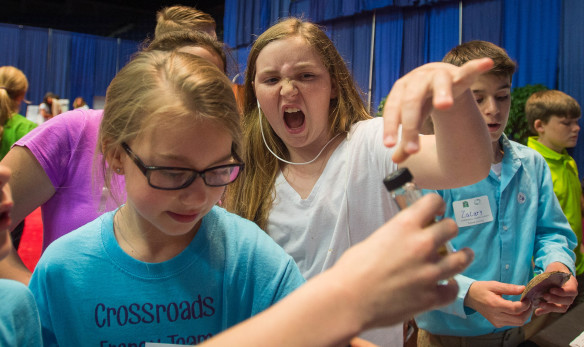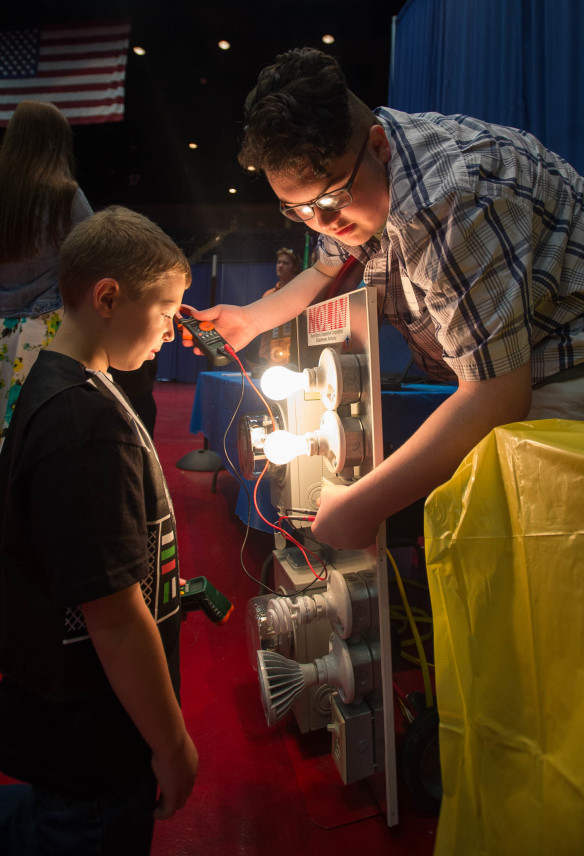
Maddy Tobbe, a 5th-grader from Crossroads Elementary (Bullitt County) reacts to a preserved insect at the Kentucky Department of Water booth at the Youth Summit and Awards Luncheon.
Photo by Bobby Ellis, April 28, 2016
By Brenna R. Kelly
Brenna.kelly@education.ky.gov
When their 8th-grade science classroom was a consistently chilly last winter, students in the West Hardin Middle School Green Club decided to do something about it.
They collected 243 soda cans, painted them black, glued them inside a wooden box and covered it with Plexiglas. Then they lifted the box into the window and attached a fan.
“The solar energy makes the cans warmer since they are black and absorb heat,” said 8th-grader Claire Thomas. “When the air comes out, it’s warmer and we use it to heat up our room.”
And it’s not only the six students in the club who learned something from the solar heater project, said teacher Emilee O’Brien.

Bryce Williams, a senior at the Hardin County Early College and Career Center, demonstrates energy usages for different light bulbs to Mason Douglas.
Photo by Bobby Ellis, April 28, 2016
“All of my students, and I have probably 200 kids who come through my room every day, will ask about it,” she said. “It gives us a great opportunity to start talking about energy.”
O’Brien’s students recently had the opportunity to talk about energy and show off their heater at the ninth annual Youth Summit and Awards Luncheon in Frankfort.
The event, designed to recognize the best projects that promote school and community health and environmental sustainability, is sponsored by the Kentucky Green and Healthy Schools (KGHS) program and the Kentucky National Energy Education Development (KY NEED) Project.
More than 200 students from across the state attended the event where Vivian Bowles, teacher at Kit Carson Elementary School (Madison County), was named KGHS Teacher of Year.
The event also marked the first year of the revised Kentucky Green and Healthy Schools program, which was revamped to better fit with the new Kentucky Academic Standards for Science, said Elizabeth Schmitz, director of the Kentucky Environmental Education Council, which sponsors KGHS.
“It’s designed to really get students using their school buildings and grounds to engage in the science and engineering practices of making observations, asking questions, defining problems, gathering and analyzing data, and designing and implementing solutions to improve the health, safety and environmental sustainability of school campuses,” she said.
That’s exactly what students at Shelby County High School did. The students on the school’s Green Team noticed that the woods around the school were filled with invasive species.
After a Department of Fish and Wildlife official taught the students what to look for, they spent their Rocket Time – an hour a week set aside during the school day for clubs – cutting down winter creeper and honeysuckle vines.
“We’ve learned about how the ecosystems surrounding the school are often forgotten,” said 9th-grader Noah Gartland. “So we as students should step up and do something.”
Shelby County High School science teacher Karin Ceralde said the students have learned much more than just how to identify invasive plants. They created long-term plans, designed a T-shirt for the team, took pictures and created a presentation.
“It fits really well with our new science standards, especially having students investigate problems and find solutions,” Ceralde said. “Most of what happens, happens because they did it, not because I did it. They have really taken on a lot of leadership roles in it.”
Education and Workforce Development Cabinet Secretary Hal Heiner encouraged the students to continue their interest in the environment and energy, and to pursue careers in STEM (science, technology, engineering and math) fields.
“We have a real shortage of people entering those fields in Kentucky,” he said. More than 100,000 jobs in the state could be filled by people with STEM skills, Heiner said.
“We’re in a dangerous spot right now,” he told the students. “We have a lot of businesses, they cannot find people that have the skills that you showed today at your tables. They are looking for you.”
Heiner commended the students’ projects and pointed out that they used science, worked as a team and found solutions to real-world problems.
“What you did is exactly what goes on in the work world,” Heiner said. “And let me tell you, there are really big problems in Kentucky, in the United States and in the world just waiting for you as part of a team like this to come and solve those problems.”
Hardin County senior Jake Dawson and his classmates at the Hardin County Career and Early College Center are doing just that. Twelve students at the school are the first students in the state in the energy management career pathway, said their teacher Joe Stuecker.
At the luncheon, the class was demonstrating the difference that cellulose insulation makes as compared to fiberglass insulation using two light bulbs under the insulation with thermometers to measure the heat. The students explained that the fiberglass heated up quickly, while the cellulose stayed at a consistent temperature.
The career pathway started this year after Stuecker’s students expressed interest in energy said, Stuecker, an electrical engineer who started teaching two years ago. The students in his advanced manufacturing class were building a robot and needed an energy source.
“They were more interested in the energy side more than anything else,” he said. So he worked with Kentucky Community and Technical College in Madisonville, which offers an associate degree in energy management.
“They do an online portion with Madisonville, then they do the hands-on in class with me,” he said. Students are now preparing to take an industry certification test and they also will receive college credit.
When Dawson graduates this spring, he will have 12 hours of college credit and a job.
Dawson will start work in July at Metalsa, a truck frame manufacturer in Elizabethtown. Dawson will work three days a week and go to KCTC Elizabethtown two days a week. The job is part of the Kentucky Federation for Advanced Manufacturing Education program, which is designed to address the shortage of high-skilled technical workers in the state.
“It’s a really great program and they also pay for school,” Dawson said. “I’ve got my future pretty well lined up.”
MORE INFO …
Elizabeth Schmitz Elizabeth.Schmitz@ky.gov



Leave A Comment